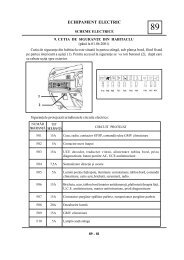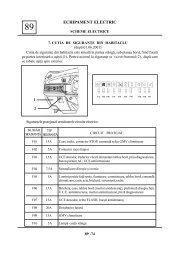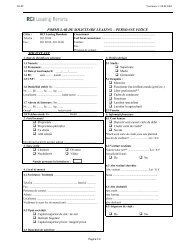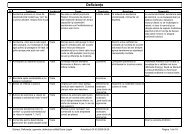Logan: A programme to win new international ... - Dacia Club
Logan: A programme to win new international ... - Dacia Club
Logan: A programme to win new international ... - Dacia Club
You also want an ePaper? Increase the reach of your titles
YUMPU automatically turns print PDFs into web optimized ePapers that Google loves.
1PRESS RELEASE FOR IMMEDIATE PUBLICATION<strong>Logan</strong>: A <strong>programme</strong> <strong>to</strong> <strong>win</strong><strong>new</strong> <strong>international</strong> cus<strong>to</strong>mersfor the profitable growthof the Renault groupThe best of Renault technology for a modern, reliable car that a broad range of<strong>international</strong> buyers can afford.<strong>Logan</strong>, a three-box saloon, is the first model in the X90 range, designed first andforemost <strong>to</strong> suit the au<strong>to</strong>mobile needs of <strong>new</strong> markets with high growth potential.<strong>Logan</strong> was developed entirely by Renault over the past four years, using all engineeringexpertise department. The use of the design-<strong>to</strong>-cost method in designingthe vehicle, carry-over of parts <strong>to</strong> optimize reliability and running costs, and digitaldesign made it possible <strong>to</strong> meet the very low <strong>programme</strong> costs set at the start of theproject. As the production of a modern vehicle was at the core of specifications,<strong>Logan</strong> was developed on the B platform used by the Renault-Nissan Alliance for theNissan Micra and Renault Modus.In addition <strong>to</strong> the <strong>Logan</strong> <strong>programme</strong> costs, Renault has invested €489 million inthe X90 <strong>programme</strong>. Most of that sum was devoted <strong>to</strong> modernizing <strong>Dacia</strong>’s manufacturingfacilities. In addition <strong>to</strong> the Pitesti pilot plant in Romania, <strong>Logan</strong> isscheduled for production at other, highly competitive production sites in Russia,Morocco, Colombia and Iran. On some markets (Russia, Iran, Colombia), whereRenault has a limited presence, <strong>Logan</strong> will be <strong>win</strong>ning <strong>new</strong> cus<strong>to</strong>mers for theRenault brand. On other markets, the car will carry the <strong>Dacia</strong> badge.Modern, spacious and very competitively priced, <strong>Logan</strong> offers unrivalled roominessin its price segment. It seats five comfortably and boasts an extremely largeboot. Specifications fully deliver the reliability and robustness required by <strong>Logan</strong>’sconditions of use (extreme climates, road networks of varying quality...). Itsmodern and attractive design are in line with <strong>international</strong> standards. <strong>Logan</strong> hasall the fundamentals of a modern vehicle, with dynamic features and safetyspecifications that meet European standards.
<strong>Logan</strong> will go on sale in Romania in September 2004, then in some 30 countries bySeptember 2005. The aim of the <strong>programme</strong> is <strong>to</strong> sell 700,000 vehicles a yearby 2010. That will make a very significant contribution <strong>to</strong> the Renault group’soverall target of 4 million vehicles.
3ContentsChapter 1 A vehicle for specific conditions in targeted markets p. 5• Record spaciousness p. 5• Reliability and robustness beyond reproach p. 5• A resolutely <strong>international</strong> design p. 6Chapter 2 All the fundamentals of a modern vehicle p. 9• Safety features in line with European standards p. 9• Travelling pleasur p. 11• Modern powertrains p. 12• Contemporary design p. 14Chapter 3 Making and selling <strong>Logan</strong> close <strong>to</strong> the markets p. 17• An <strong>international</strong> manufacturing project p. 17• A practical sales strategy tailored <strong>to</strong> the markets p. 17• A full range of services p. 17• <strong>Logan</strong> at the heart of Central and East European markets p. 18
5CHAPTER 1A vehicle for specific conditionsin targeted marketsRecord spaciousnessThe cus<strong>to</strong>mer groups targeted by <strong>Logan</strong> are mainlyfamilies, most of whom have only one vehicle. <strong>Logan</strong>will also appeal <strong>to</strong> the business market, particularlyfor use as a taxi.The boot volume of 510 litres is best in class. TheHyundai Accent and Daewoo Lanos Sedan provide321 and 395 litres respectively. Moreover, the shapeof the boot enables a wide variety of different-shapeditems <strong>to</strong> be loaded.Pho<strong>to</strong>is de juin : n° 013The car’s generous dimensions make it exceptionallyspacious. Its length (4250mm, compared <strong>to</strong> the KiaRio Sedan’s 4215mm), width (1735mm, compared <strong>to</strong>1670mm for the Hyundai Accent) and height(1525mm, compared <strong>to</strong> 1495 for the Chevrolet /Daewoo Kalos) are unrivalled in saloons in the B-entry segment , and are in fact closer <strong>to</strong> the norms forthe C segment. <strong>Logan</strong>’s roomy interior is another pluspoint, and the rear seats were the subject of specialattention. Three very tall passengers (those who fallin<strong>to</strong> the 95th percentile of over 1.90 metres) can beseated in comfort with headroom of 25mm.Reliability and robustnessbeyond reproachIn countries that are a priority target for <strong>Logan</strong>, cus<strong>to</strong>mersdrive about 20,000 kilometres a year. A car’sfirst owner keeps it for an average of five <strong>to</strong> six years,and over eight years in some countries. That meansrobustness and low running and maintenance costsare a <strong>to</strong>p priority.Footroom is also generous, with a width of 420mm.Cus<strong>to</strong>mers in very cold countries will find plenty ofroom for bulky <strong>win</strong>ter clothing and shoes. Kneeroomis 185mm on average, compared <strong>to</strong> 173mm for theChevrolet / Daewoo Kalos. Rear shoulder room is aremarkable 1420mm, close <strong>to</strong> that of Vel Satis andmore than <strong>Logan</strong>’s rivals (1342mm for the Chevrolet /Daewoo Kalos). Getting in<strong>to</strong> and out of the car is alsovery easy thanks <strong>to</strong> wide-opening, generously proportioneddoors.The project team refused <strong>to</strong> compromise on reliabilityand durability. All the technical decisions weremade with this in mind, on the basis of a design thatemphasized simplicity.The 1.4l and 1.6l eight-valve engines (the K-series)and JH gearbox have already proved their worth in theRenault range, especially in overseas export markets.Renault’s engineers worked closely with suppliers,and a daily check was introduced <strong>to</strong> ensure that partsfor the <strong>new</strong> model complied with specifications.1The B-Entry segment covers vehicles, usually older models, whichfall in<strong>to</strong> the C segment by size and the B segment by price.
<strong>Logan</strong> was subjected <strong>to</strong> stringent tests covering a verywide variety of driving conditions. Renault engineersdrove 470,000 kilometres on the “overseas export”circuit at the company’s road-proving ground inAubevoye, Normandy. The circuit features an abundanceof dust, s<strong>to</strong>nes and fords with a view <strong>to</strong> wearingout vehicles three times faster than they would do onstandard European roads.The engineers focused on simple, practical techniquesfor easy servicing. The headlamp bulbs canbe easily reached from the engine compartment, sothat cus<strong>to</strong>mers can change them themselves.A resolutely <strong>international</strong> design"<strong>Logan</strong> will be on the roads of all the continents. FromSouth America <strong>to</strong> Asia via Eastern Europe and Africa,it will have <strong>to</strong> cope with conditions that are as variedas they are demanding. So the specifications <strong>to</strong>okaccount of requirements in the most difficult countries,from the hottest <strong>to</strong> the coldest", said LucAlexandre Ménard, Renault’s Senior Vice President,International Operations, and Chairman of <strong>Dacia</strong>.<strong>Logan</strong> was tested in extreme temperatures on climatictest benches at the Aubevoye and Lardy technicaltesting centres – the final stage before the car wassent <strong>to</strong> the Arctic Circle and tropical countries forreal-life trials.<strong>Logan</strong>’s heating and air conditioning systems aretherefore suitable for climates as extreme as those ofRussia and the Gulf states. They were developedaccording <strong>to</strong> the same specifications as those used forthe Clio sold in Mexico.<strong>Logan</strong> has a six-year anti-corrosion warranty.Bodywork is protected by injecting wax in<strong>to</strong> the boxsections, systematic waterproofing of the externalcabin joints and reinforced underbody gravel protection.The <strong>new</strong> vehicle is competitively priced and inexpensive<strong>to</strong> run. Maintenance costs were the subject ofclose study. Using Renault technology, the engineersmanaged <strong>to</strong> extend the intervals between services. Onsome markets, for instance, the oil, spark plugs andair filter are changed only every 30,000 kilometres.
7Thermal comfort is the same throughout the car,including the rear seats. Short ducts in the frontensure excellent distribution of warm or cool air <strong>to</strong>passengers’ feet. In the back, the air distribution issuited <strong>to</strong> countries that have harsh <strong>win</strong>ters. The systemhas a t<strong>win</strong>-pipe outlet like the one in Mégane II, andis compatible with the use of snow trays beneathpassengers’ feet.Because the engine warms quickly and suppliessufficient heat, additional heating is not needed. Theair conditioning unit is taken from B-platform vehicles,with certain adaptations made specially for<strong>Logan</strong>. It is very compact, freeing up space in thecockpit. The upper and lower vents ensure optimumdistribution of air flows.<strong>Logan</strong> is also suitable for difficult road surfaces. The155mm ground clearance is 20mm higher than that ofa vehicle designed for use in Western Europe. Thatmeans it can be driven on uneven road surfaces, insteep mountain areas and even on dirt tracks at moderatespeed without any damage. The powertrains, airconditioning and opening panels were all designed foran environment where dust is everywhere.The engines can run on fuel of widely differing quality.They are designed for 95-octane fuel, but have alsobeen approved for use with 87-octane and 91-octanefuel. Tests have also checked that the powertrainsfunction with a starting temperature of minus 30°C.<strong>Logan</strong> complies with the standards in force in theEuropean Union. Both engine options (75hp 1.4l and90hp 1.6l) were developed in line with the most recentemission control standards and have Euro 4 approval.<strong>Logan</strong> also complies with European standards asregards front and side impacts. More restrictive legislationin some countries means the specifications areeven stricter there. This is the case in Saudi Arabia,which has particularly demanding standards for rearimpacts.For external noise, <strong>Logan</strong> is in accordance with thethreshold set by the relevant European directive(74db). In this respect, the vehicle follows the commitmentmade by Renault since the launch of Laguna II:<strong>to</strong> make its vehicles even quieter than required by law.Recyling materials was also taken in<strong>to</strong> account.<strong>Logan</strong> is 95% recyclable in terms of weight, as currentlegislation demands.
9CHAPTER 2All the fundamentalsof a modern vehicleSafety features in line with Europeanstandards<strong>Logan</strong> was the subject of intensive work regardingsafety. Renault’s safety engineers made every effort <strong>to</strong>find different solutions from those usually adopted formore conventional cars <strong>to</strong> provide features very close<strong>to</strong> those of the latest-generation Renault models.Digital technology has made it possible <strong>to</strong> drop severalphysical stages in the development process. “Theuse of digital simulation meant we could check thecar’s resistance <strong>to</strong> impacts and eliminate risks earlyon in the process. Those findings were confirmed bycrash tests conducted on the final versions of thevehicle”, said Jean-Marc Dubois, the project’s PassiveSafety Manager.<strong>Logan</strong> has benefited from Renault’s acknowledgedexpertise in impact resistance. The vehicle’s structurecrumples <strong>to</strong> disperse the kinetic energy generated bya crash. When a frontal impact occurs, the layout ofthe engine compartment has been designed <strong>to</strong> allowstacking of the powertrain components. In the upperpart of the vehicle, the load passes through the cowlside reinforcement, door pillar and door panels. Inthe middle, the load is taken up by the front crossmember.Finally, the lower part of the car absorbsenergy through a subframe which is connected <strong>to</strong> thelongeron at six points.
The dashboard is also of major importance in providingcrash protection in frontal impacts. Its honeycombstructure, made of highly absorbent polypropylene,lowers the risk of knee injury should an impact occur.The rounded lower part and glove compartment lidare shaped <strong>to</strong> spread the load on passengers’ legsand ankles, while the structure of the seats maintainsthe pelvis in an appropriate position <strong>to</strong> cope with animpact. Underfoot padding for both driver and frontpassenger provides added protection for the legs.In the event of a side impact, the central pillar protectsthe pelvis, complementing the lateral resistanceprovided by the seats and door padding.Rear impacts were also the focus of attention. Thefuel tank is located under the floorpan, away from therear suspension, so there is less chance of it beingpierced by the underbody or suspension components.A cross-member in the back of the rear bench seatrestricts the danger of objects in the boot entering thecabin.Seat belts are a car’s main passive safety feature.Research has shown that if everyone wore them,between 8,000 and 10,000 lives could be saved everyyear in Europe alone. <strong>Logan</strong> has three-point beltsand headrests for all seats. The front belts can beheight-adjusted for occupants of different sizes. Twospecially-designed airbags, for the driver and passenger,are available as options. They are equipped withvents that regulate internal pressure and restrict theload on the occupants.
11<strong>Logan</strong> ensures safety for passengers of all sizes andages. Both front-facing and rear-facing child seatscan be fitted in all three rear seats as well as the frontpassenger seat. The airbag can be disconnected usinga switch on the dashboard when a child is travelling inthe front, and a reminder light comes on.The vehicle has MacPherson-type front suspensionwith a wishbone link, based on the system used in ClioII. The rear suspension is an H-section <strong>to</strong>rsion beamwith <strong>programme</strong>d layout, combined with helicalsprings and vertical dampers.Suspension travel is greater than that in vehiclesintended for the West European market. Extensiveresearch in<strong>to</strong> the stiffness of the front and rearsprings restricts body movements, especially roll,giving <strong>Logan</strong> similar ride comfort <strong>to</strong> that of an entrylevelClio. On the <strong>to</strong>p versions, the chassis has a frontanti-roll bar for enhanced body control. These vehiclesare also equipped with hydraulic power-assistedsteering, ABS and 15-inch wheels.Travelling pleasure<strong>Logan</strong> has mechanical steering on the entry-levelversions and power-assisted steering on the <strong>to</strong>p versions.The mechanical steering was developed <strong>to</strong> providethe best possible compromise between ride comfortand driving precision. The power-assisted steering,in conjunction with the fitment of a front anti-rollbar, delivers superior handling and improvesmanoeuvring. <strong>Logan</strong>’s turning circle is 10.50 metres –the same as that of Mégane II.Driving pleasure depends on accurate handling andprecise steering, but also on the ergonomics of thedriving position. All the data displayed can be taken inat a glance. An alphanumeric display in the centre ofthe dashboard brings <strong>to</strong>gether warning lights anddata supplied by the onboard computer.<strong>Logan</strong> is fitted with disc brakes in front and drumbrakes at the rear. It has the Bosch 8.0 ABS system –the same as Mégane II – with Electronic BrakeDistribution, which takes full advantage of the rearaxle’s braking potential.
<strong>Logan</strong>’s ergonomic driving position benefits fromB-platform architecture. The driver is ideally positionedin line with the steering wheel and pedals,making driving more comfortable.The car body was designed using digital technology.Numerous calculations concerning vibrations andacoustics helped <strong>to</strong> keep noise levels low. Mechanicalnoise was the focus of special attention throughoutthe development process, with high-frequencysounds filtered for maximum homogeneity. <strong>Logan</strong>’sair conditioning and ventilation systems are amongthe quietest in the segment, at 51db and 49db respectively.Modern powertrains<strong>Logan</strong> will be launched with a choice of two petrolengines: the 75hp 1.4l and 90hp 1.6l. A 65hp 1.5 dCidiesel option will be available in 2005, as well as a107hp 1.6l 16V petrol unit.“We used several decisive criteria in choosing theengines: cost, durability, versatility and ease of maintenance”,said Alain Picard, Engine DevelopmentProject Manager. The eight-valve engines in the K7series have already proved their worth in severalRenault vehicles, and are still used on the Clio Saloonand Kangoo. They feature substantial <strong>to</strong>rque at lowspeeds, available over a broad range from 3,000rpm<strong>to</strong> 4,500rpm.The 75hp 1.4l engine delivers power output of55kw (75hp) at 5,500rpm and <strong>to</strong>rque of 112Nm at3,000rpm.The 90hp 1.6l unit supplies 64kw (90hp) at5,500rpm and 128Nm at 3,000rpm. Both engines arehooked up <strong>to</strong> the five-speed manual gearbox usedin Laguna II and Mégane II.
13On the 75hp 1.4l and 90hp 1.6l versions, the ratios areshorter on the first three gears for better step-off andacceleration at low speeds or when the vehicle isheavily loaded. The <strong>to</strong>p two gears focus more on fueleconomy and quiet operation. The maximum speed ofthe 90hp 1.6l unit is 175kph and can accelerate from0-100kph in 11.5 seconds.The engines put <strong>Logan</strong> among the best in class interms of fuel economy, with consumption of 6.8l inthe combined cycle, or 164g of CO 2 /km for the 75hp1.4l unit.Several parts have been redesigned as part of the“design <strong>to</strong> cost” method, such as the camshaft of the75hp 1.4l engine, which now has shoe-type rockerarms – simpler and more economical than the rollertypesystem. The engineers decided <strong>to</strong> improve <strong>to</strong>rqueat low speeds by redesigning the profile of the cams.Despite its generous dimensions, <strong>Logan</strong> is a relativelightweight. The entry-level version with the 75hp 1.4lengine tips the scales at only 975kg. This contributes<strong>to</strong> performance and fuel economy on a par with othervehicles in the Renault range.
Contemporary design“We had all-round designers working on the project,combining sound technical knowledge with a creativeapproach <strong>to</strong> provide ingenious solutions <strong>to</strong> the projectgoals”, said Ken Melville, Direc<strong>to</strong>r, Medium and <strong>Dacia</strong>Car Programmes Design.The challenge for <strong>Logan</strong>’s exterior was <strong>to</strong> design amodern, stylish vehicle that both fitted in with the waycars are used in the target countries and compliedwith the ceiling on manufacturing costs. The choice ofa three-box body seemed obvious from the startbecause it is regarded as a status symbol in emergingeconomies. The design expresses robustness andquality, with clearly accented wheel arches, taut bodysides and a sculptured bonnet. Form and function areindissociable: the shape of the boot provides a lowloading platform and is protected by the boot liningfrom the upper part of the rear bumper. The rear lampclusters, set at an angle, smooth out the car’s structurededges.The frontal styling highlights the <strong>new</strong> <strong>Dacia</strong> brandidentity, first seen on the Solenza, and is a <strong>win</strong>dow onthe brand’s future models. The <strong>new</strong> badge stands outprominently on the grille. Smooth headlamp coversunderscore the modern look of the front of the vehicle.Particular care was paid <strong>to</strong> the interior design. Bothfit and finish and the materials used echo the robustnessand quality of the exterior. A dashboard mouldedin one piece was chosen because it does away withthe problem of clearance, the screws that keep it inplace can be concealed, and durability is assured. Thecentral console groups controls such as air conditioningand radio but<strong>to</strong>ns, all easy <strong>to</strong> reach and operate.The discreet, functional design adds <strong>to</strong> the enjoymen<strong>to</strong>f travelling in <strong>Logan</strong>. The steering wheel dials andcontrols enhance the vehicle’s dynamic, modernappearance and the cockpit, focusing on the driver,clearly expresses driving pleasure.
15The various versions in the <strong>Logan</strong> range can be recognizedat first glance, sending a clear signal <strong>to</strong> cus<strong>to</strong>mers.The Ambiance version stands out from theentry-level version with the lower part of the bumpersbody-coloured, chrome-look trim on the grille, protectiveside mouldings and distinctive hubcaps.The <strong>to</strong>p version, Lauréat, has fully body-colouredbumpers, 15” wheels, a short strip of chrome beadingaround the grille and integral foglamps.In addition <strong>to</strong> these three versions, specific versionsmay be introduced for some countries. The interiorsof the different versions are differentiated by lighteror darker shades of material and by specific treatmen<strong>to</strong>f the central console. Two colour schemes areavailable: medium charcoal and nutmeg. Differentupholstery fabrics are used, and in some versions thefabric also features on the door panels. The design ofthe hubcaps and aluminium wheels reinforces theconcept of steps up through the versions.<strong>Logan</strong> is painted with bright, <strong>new</strong>, contemporarycolours such as Aegean Blue and Fern Green, with ametallic finish.
17CHAPTER 3Making and selling <strong>Logan</strong> close<strong>to</strong> the marketsAn <strong>international</strong> manufacturing project“The X90 project forms part of Renault’s <strong>international</strong>growth strategy, which is targeting worldwide productionof over 700,000 units of this model by 2010”, saidGérard De<strong>to</strong>urbet, Vice President, Worldwide X90Programme. Production of <strong>Logan</strong> at <strong>Dacia</strong>’s Pitestiplant will start the <strong>programme</strong> in Romania this year.In 2005 it will continue in Russia, then Morocco andColombia, and in 2006 in Iran. Assembly of <strong>Logan</strong> inRussia, Morocco and Iran will use CKD parts suppliedby the Pitesti pilot site, with some mechanical componentssupplied by Renault’s industrial sites. In addition<strong>to</strong> these countries, other <strong>international</strong> prospectsare opening up for the X90 project.A practical sales strategy tailored<strong>to</strong> the markets<strong>Logan</strong> is a 100% Renault car (technology, development,chassis, powertrain, manufacturing standards),particularly suited <strong>to</strong> its target markets. Its modernity,reasonable price, loading capacity, five full-sizeseats and ease of repairs and maintenance are its keystrengths. <strong>Logan</strong> will carry the Renault badge in somemarkets, such as Russia and Iran, underscoring thecompany’s faith in the product.Whether the <strong>Dacia</strong> or Renault badge is used willdepend on the characteristics of each market and onhow long and in what circumstances Renault hasbeen established there.The <strong>Dacia</strong> brand will help <strong>to</strong> conquer <strong>new</strong> cus<strong>to</strong>mertarget groups. <strong>Dacia</strong>, with its <strong>new</strong> brand identity as amodern, ambitious company and <strong>new</strong> badge, will beselling a range of modern, robust, reliable and affordablevehicles. In the countries of Central Europe, aswell as in Turkey, northern Africa, the Middle East andsub-Saharan Africa, <strong>Logan</strong> will be marketed underthe <strong>Dacia</strong> brand <strong>to</strong> round out Renault’s range. It willbe positioned in the entry-level segment, which in acountry like Poland accounts for 30% of the <strong>to</strong>tal marketand is hardly covered by the current Renaultrange.In other countries such as Iran, where Renault is notestablished, the segmentation issue is less important.The features of these markets (income, rate of carownership, what is available from local au<strong>to</strong>makers)make <strong>Logan</strong> suitable for a broad base of cus<strong>to</strong>mersbuying their first car. In these cases, it will be marketedunder the Renault brand.A full range of servicesRenault’s financial services, run by RCI Banque andits subsidiaries, will provide specific proposals forprospective <strong>Logan</strong> buyers, depending on the country.For aftersales service, the <strong>Dacia</strong> Spare Parts Centrewill supply all <strong>Logan</strong>’s markets. The centre, which hashandled all distribution of genuine spare parts andaccessories for the <strong>Dacia</strong> brand since May 2003,manages more than 20,000 <strong>Dacia</strong>, Renault and Nissanitems. Located in Bradu, near the Pitesti plant, itemploys about 100 staff and represents investment of€14 million. The centre has direct access <strong>to</strong> majorroad networks and is near the Pitesti cus<strong>to</strong>ms point.<strong>Dacia</strong> is also planning <strong>to</strong> develop a full range of accessoriesfrom items such as <strong>to</strong>wbars and roof bars <strong>to</strong>mud flaps, with the support of Renault’s Parts andAccessories Division.
<strong>Logan</strong> at the heart of Central and EastEuropean marketsAfter Romania, Central Europe will be the focus for<strong>Logan</strong> sales, with the backing of the Renault network.Renault was the second <strong>to</strong>p-selling brand in theregion in 2003, with market share of 11%.Marketing of <strong>Logan</strong> will be backed up by a range ofservices covering sales, finance and aftersales.Specific finance offers have been devised by RCIBanque. From 2005 the future Renault-Nissan spareparts centre in Györ, Hungary, will become a regionalhub for supplying <strong>Dacia</strong> spare parts <strong>to</strong> the countries ofCentral Europe.A sales manager will be appointed specifically for thebrand in each country. Distribution will be handled bythe Renault network's partners. Depending on themarket, <strong>Logan</strong> will be sold by a Renault dealer with a<strong>Dacia</strong> area featuring special signage or in a <strong>Dacia</strong>showroom. A two-year warranty will apply in mostcountries. Distribution by the Renault network isreassuring for cus<strong>to</strong>mers, offering them the best possiblelevel of services. Maintenance and repairs atshared Renault-<strong>Dacia</strong> workshops provide a furtherguarantee of optimum quality.
<strong>Dacia</strong> Communications Contact: + 40 248 50 21 11Email: dacia.press@daciagroup.comRenault Product Press Contact: + 33 (0)1 41 04 63 36Renault Corporate Press Contact: + 33 (0)1 41 04 64 69Web sites: www.media.renault.com – www.renault.com













